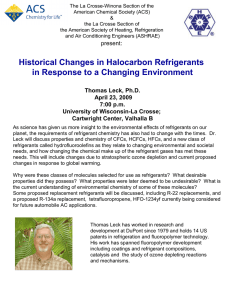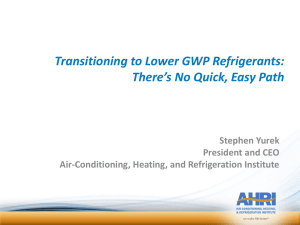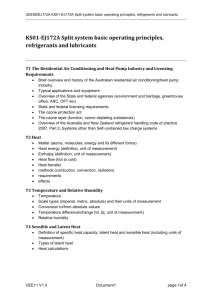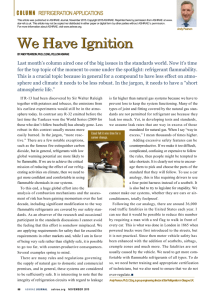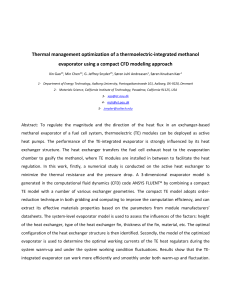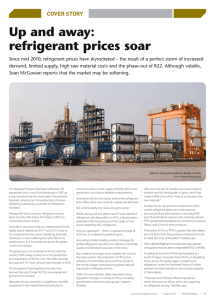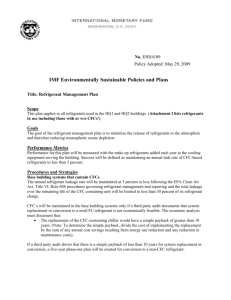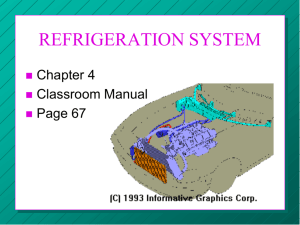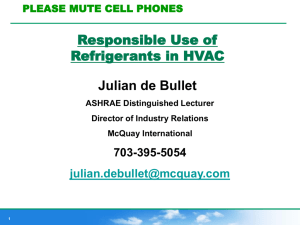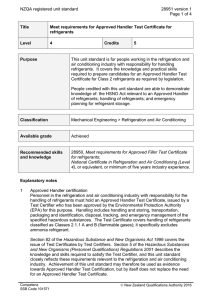Objectives
advertisement
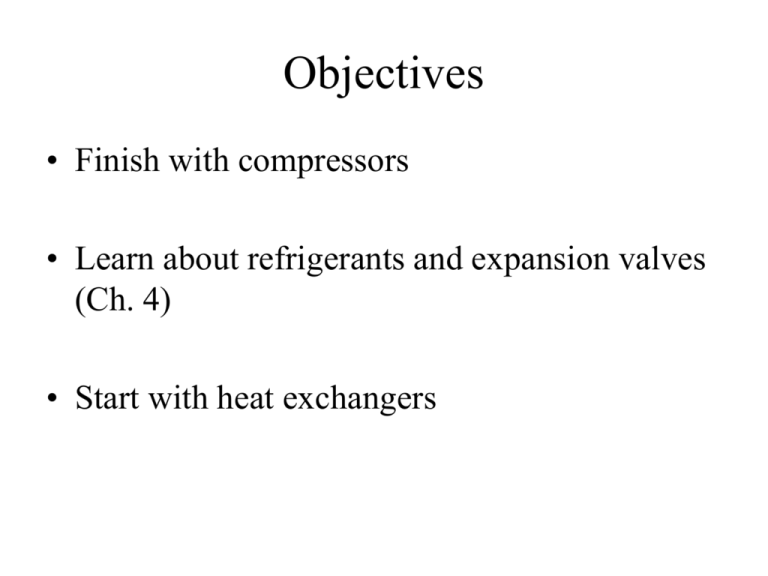
Objectives • Finish with compressors • Learn about refrigerants and expansion valves (Ch. 4) • Start with heat exchangers Summary • Many compressors available • ASHRAE Handbook is good source of more detailed information • Very large industry Expansion Valves • Throttles the refrigerant from condenser temperature to evaporator temperature • Connected to evaporator superheat • Increased compressor power consumption • Decreased pumping capacity • Increased discharge temperature • Can do it with a fixed orifice (pressure reducing device), but does not guarantee evaporator pressure Thermostatic Expansion Valve (TXV) • Variable refrigerant flow to maintain desired superheat AEV • Maintains constant evaporator pressure by increasing flow as load decreases Summary • Expansion valves make a big difference in refrigeration system performance • Trade-offs • Cost, refrigerant amount • Complexity/moving parts Refrigerants What are desirable properties of refrigerants? • • • • • • Pressure and boiling point Critical temperature Latent heat of vaporization Heat transfer properties Viscosity Stability In Addition…. • • • • • • • • Toxicity Flammability Ozone-depletion Greenhouse potential Cost Leak detection Oil solubility Water solubility Refrigerants • What does R-12 mean? • ASHRAE classifications • From right to left ← • • • • # fluorine atoms # hydrogen atoms +1 # C atoms – 1 (omit if zero) # C=C double bonds (omit if zero) • B at end means bromine instead of chlorine • a or b at end means different isomer Refrigerant Conventions • Mixtures show mass fractions • Zeotropic mixtures • Change composition/saturation temperature as they change phase at a constant pressure • Azeotropic mixtures • Behaves as a monolithic substance • Composition stays same as phase changes Inorganic Refrigerants • Ammonia (R717) • • • • Boiling point Critical temp = 271 °F Freezing temp = -108 °F Latent heat of vaporization • Small compressors • Excellent heat transfer capabilities • Not particularly flammable • But… Carbon Dioxide (R744) • Cheap, non-toxic, non-flammable • Critical temp? • Huge operating pressures Water (R718) • Two main disadvantages? • ASHRAE Handbook of Fundamentals Ch. 20 Water in refrigerant • Water + Halocarbon Refrigerant = (strong) acids or bases • Corrosion • Solubility • Free water freezes on expansion valves • Use a dryer (desiccant) • Keep the system dry during installation/maintenance Oil • Miscible refrigerants • High enough velocity to limit deposition • Especially in evaporator • Immiscible refrigerants • Use a separator to keep oil contained in compressor • Intermediate The Moral of the Story • No ideal refrigerants • Always compromising on one or more criteria Heat Exchangers Systems: residential Outdoor Air Indoor Air Large building system Chiller Large building system Chiller Outdoor air 95oF 53oF Water from building Water to 43oF building Heat exchangers Air-liquid Tube heat exchanger Air-air Plate heat exchanger Some Heat Exchanger Facts • All of the energy that leaves the hot fluid enters the cold fluid • If a heat exchanger surface is not below the dew point of the air, you will not get any dehumidification • Water takes time to drain off of the coil • Heat exchanger effectivness varies greatly Heat Exchanger Effectivness (ε) C=mcp Mass flow rate Specific capacity of fluid THin Heat exchanged Maximum posible heat exchange TCout THout TCin Location B Location A Example: What is the saving with the residential heat recovery system? Outdoor Air 32ºF 72ºF 72ºF Combustion products 52ºF Exhaust Furnace Fresh Air Gas For ε=0.5 and if mass flow rate for outdoor and exhaust air are the same 50% of heating energy for ventilation is recovered! For ε=1 → free ventilation! (or maybe not)
